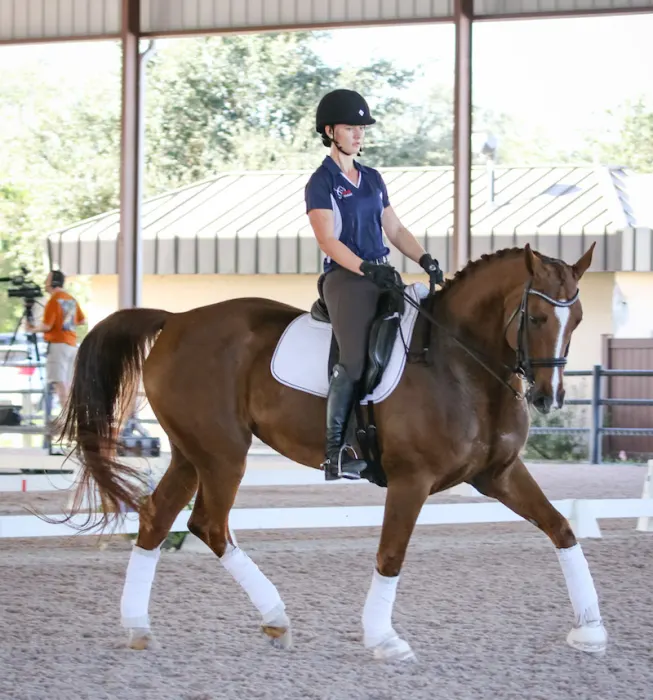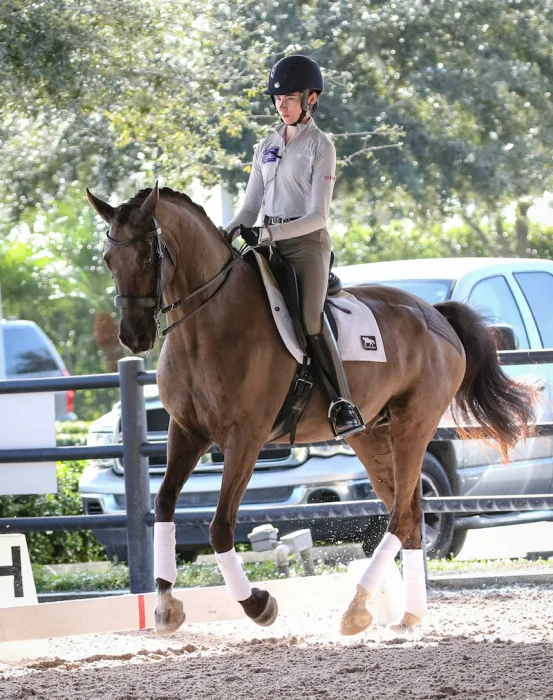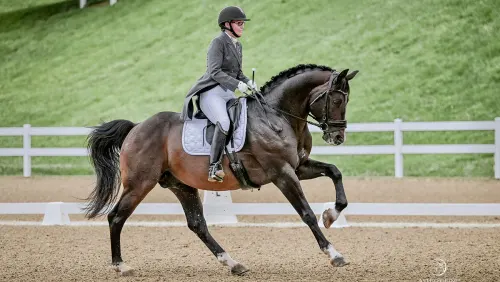Wellington, Fla.—Jan. 4
The trainers spoke in tweetable and meme-worthy quotes as they guided a group of talented young riders during Day 2 of the Robert Dover Horsemastership Week. Held at the Adequan Global Dressage Festival show grounds in Wellington, Florida, the pearls of wisdom unstrung by Robert Dover, Debbie McDonald, Jan Ebeling, Adrienne Lyle and Olivia LaGoy-Weltz kept dropping into social media-friendly sound bites like a trail of breadcrumbs for the riders and spectators to follow.
“The four things you have to own are rhythm, tempo, frame and length of stride.”—Robert Dover
Dover told both Nicole Scarpino riding Lambada 224 and Christian Simonson on FRH Rassolini that every rider should take ownership of this quartet of qualities while letting the horse take care of the rest.
“From half-halt to half-halt, you have to own the rhythm of their footfalls in each of the three gaits and the tempo or how fast they are going over every meter of ground in that gait,” Dover said. “Frame talks about how high or low [the horse] is, how long she is or how short she is. Think about a frame for a picture. A frame can be for a square picture or a rectangular picture. And then think about what kinds of walks and canters and trots there are. There are collected walks and extended walks, collected trots and extended trots.”
“You really have to think about being present.”—Debbie McDonald
When Anna Weniger was over-riding her left rein and forgetting about the right rein and leg, McDonald told her to take it easy, ride her horse, Don Derrick, straighter through the right rein, keep her right leg on him and be present on both sides of the horse.
“Keep breathing and keep thinking about the way you are riding now, because you know what it takes to keep him on that,” McDonald said. “You can let him go, but when you bring him back, you have to be present.”
ADVERTISEMENT
“You ask once, and then you take your legs away, and you get it done.”—Adrienne Lyle
All the trainers were focused on making the horses reactive to the aids and the riders more effective. Lyle wanted an instant reaction from Melanie Doughty and her mare, Fascinata, followed by a firm half-halt so the horse didn’t run away from the aids. She instructed Doughty to go from teeny, tiny walk steps to pushing Fascinata forward. “Remember, not jabbing spurs,” Lyle said. “That was 10 requests. I want one request. Make her jump forward. Bring her back a little, and if she doesn’t jump forward, give her a kick.”
When the mare still didn’t react, she told the rider to give the mare a thump to make her jump forward. “One time. Good. Now tell her ‘Good girl.’ ”

Adrienne Lyle worked with Melanie Doughty on improving her mare Fascinata’s responsiveness to the leg.
Lyle said it’s important the horse doesn’t feel trapped in front when she was pushed forward. It’s also important to be consistent. “If she doesn’t think you are going to follow through with that every time, then she’s going to think, ‘She’s just going to kick me once and stop asking, so I’m just going to not get faster, and she’ll give up.’ She needs to learn that she can stay through and stay hot to the leg. That’s what you need to get to the next level.”
“When you have to use your spur or a whip, I want it to be like he was struck by lightning.”—Robert Dover
There’s a caveat to this one, Dover told Scarpino. He advocates whispering the aids and resorting to a light spur or tap with the whip only when necessary. He reminded his riders to give an aid and expect the horse to go forward, but pestering the horse is not the answer. “The more leg you keep on them, the less electric they are,” he told Scarpino. “Use fewer touches to make them count more.”
He said a rider needs to get to the point where just the intention of moving her foot back would send her mare forward, into the bridle and round. “Go back to that as a basic,” he said. “Keep on refining your tools until you refine them so much that both of you believe in the horse’s abilities to be really hot, electric, supple and engageable.”
LaGoy-Weltz embellished on the theme that the rider can’t do all the work and the horse has to help carry the responsibility.
ADVERTISEMENT
“He has all the capabilities in there, but it’s getting him to put in all the muscle tone and effort to hold himself together,” LaGoy-Weltz told Camille Molten, who was riding her Danish Warmblood, Heros. “I think he really lets you do a lot of holding him together. When you get all his energies aligned, he comes into a different package.”
And the way to do that? Transitions. But not just any transitions. Good transitions.
“Every transition has to be a good transition. Don’t practice any transition that’s not right.”—Olivia LaGoy-Weltz
And, as the trainers had the riders transition from collected walk to extended walk or passage to walk and back again, lots and lots of transitions were executed throughout the morning in all three dressage courts. Ebeling was particularly adamant about the importance of transitions to Juliette Cain riding her own Mariska.
“Transitions, transitions, transitions and, when you are done with them, more transitions.”—Jan Ebeling
The trainers are all business but each of them seemed to have the best interest of the horses and riders at heart. The most memorable meme of the day came from Dover when he instructed a rider to never fail to come to ride without sugar in her pocket to reward her horse.
“You can’t train a seal without a fish.”—Robert Dover
“Look, there’s no pot of gold at the end of the rainbow for them,” he said. “You can train them to know they are going to get a treat at the end of the day. Keep sugar in your pocket and even if he doesn’t take it, put it up to his mouth. Then, after a few weeks he’ll take it and then he’ll actually start looking for it.”
The Robert Dover Horsemastership Clinic continues through Jan. 6 at the Adequan Global Dressage Festival showgrounds. You can watch the action live-streamed on the USEF Network.



















